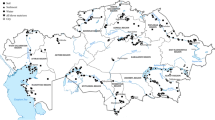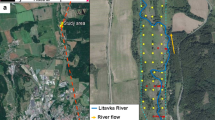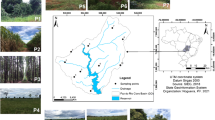Abstract
A brief review on the occurrence of high natural concentrations of potentially toxic elements (PHEs) in soils and water is presented, analysing also various approaches and strategies applied in different Countries to address the problem of “natural” contamination. Starting from the well known case of arsenic, the situation for other elements such as beryllium, uranium and nickel, among the most interesting, is analysed. The analysis is based on already evidenced geochemical anomalies and on the possible evolution both in the estimate of their toxicological effects and the redefinition (lowering) of the limits at the moment imposed by legislation or suggested by guidelines. New data obtained in the ENEA laboratory in the last years on arsenic and beryllium are presented. The growing need of “geochemical maps” at regional, national and European level and of a continuous monitoring activity is highlighted. At the same time the importance of considering concentration and speciation of elements and how an element is bound and under what circumstances it may be bioavailable and able to damage the ecosystem, is recalled. Finally it is suggested to concentrate efforts on the development of screening methodologies that could play a key role in the characterisation of contamination and on standardising fast procedures that enable a guided real-time survey. The clear definition of a “geochemical risk” requires a complex and multidisciplinary approach, so the emerging role of Medical Geology is underlined.



Similar content being viewed by others
References
Achene L, Ferretti E, Lucentini L, Pettine P, Veschetti E, Ottaviani M (2010) Arsenic content in drinking-water supplies of an important volcanic aquifer in central Italy. Toxicol Environ Chem 92:509–520
Aiuppa A, Avino R, Brusca L, Caliro S, Chiodini G, D’Alessandro W, Favara R, Federico C, Ginevra W, Inguaggiato S, Longo M, Pecoraino G, Valenza M (2006) Mineral control of arsenic content in thermal waters from volcano-hosted hydrothermal systems, Insights from Island of Ischia and Phlegrean Fields (Campanian Volcanic Province, Italy). Chem Geol 229:313–330
Albanese S, Sadeghi M, Lima A, Cicchella D, Dinelli E, Valera P, Falconi M, Demetriades A, De Vivo B et al (2015) GEMAS: cobalt, Cr, Cu and Ni distribution in agricultural and grazing land soil of Europe. J Geochem Expl 154:81–93
Ander EL, Johnson CC, Cave MR, Palumbo-Roe B (2013) Methodology for the determination of normal background concentrations of contaminants in English soil. Sci Tot Env 454–455:604–618
Angelone M, Cremisini C, Piscopo V, Proposito M, Spaziani F (2009) Influence of hydrostratigraphy and structural setting on the arsenic occurrence in groundwater of the Cimino-Vico volcanic area (Central Italy). Hydrogeol J 17:901–914
Armiento G, Cremisini C, Nardi E, Pacifico R (2011) High geochemical background of potentially harmful elements in soils and sediments, implications for the remediation of contaminated sites. Chem Ecol 27(1):131–141
Armiento G, Bellatreccia F, Cremisini C, Della Ventura G, Nardi E, Pacifico R (2012) Beryllium natural background concentration and mobility, a reappraisal examining the case of high Be-bearing pyroclastic rocks. Environ Monit Assess 185(1):559–572
Armiento G, Angelone M, De Cassan M, Nardi E, Proposito M, Cremisini C (2015a) Uranium natural levels in water and soils: assessment of the Italian situation in relation to quality standards for drinking water. Rend Fis Acc Lincei (accepted for publication)
Armiento G, Baiocchi A, Cremisini C, Crovato C, Lotti F, Lucentini L, Mazzuoli M, Nardi E, Piscopo V, Proposito M (2015b) An integrated approach to identify water resources for human consumption in an area affected by high natural arsenic content (submitted)
Baiocchi A, Dragoni W, Lotti F, Luzzi G, Piscopo V (2006) Outline of the hydrogeology of the Cimino and Vico volcanic area and of the interaction between groundwater and Lake Vico (Lazio Region, Central Italy). Boll Soc Geol Ital 125:187–202
Baiocchi A, Coletta A, Spositi L, Lotti F, Piscopo V (2013) Sustainable groundwater development in a naturally arsenic-contaminated aquifer, the case of the Cimino-Vico volcanic area (Central Italy). Ital J Eng Geol Environ 1;1–18. Sapienza Università Editrice. http://www.ijege.uniroma1.it. Accessed 17 Aug 2015
Ballantyne JM, Moore JN (1988) Arsenic geochemistry in geothermal systems. Geochim Cosmochim Acta 52(2):475–483
Bowman CA, Bobrowsky PT, Selinus O (2003) Medical geology: new relevance in the earth sciences. Episodes 26(4):270–278
Bunnell JE (2004) Medical geology, emerging discipline on the ecosystem–human health interface. EcoHealth 1(1):15–18
Carlon C (Ed.) (2007) Derivation methods of soil screening values in Europe. A review and evaluation of national procedures towards harmonization. European Commission, Joint Research Centre, ISPRA, EUR 22805-EN
Celico P, Dall’Aglio M, Ghiara E, Stanzione D, Brondi M, Prosperi M (1992) Geochemical monitoring of the thermal fluids in the Phlegrean Fields from 1970 to 1990. Boll Soc Geol Ital 111:409–422
Chouhan A, Flora SJS (2010) Arsenic fluoride: two major ground water pollutants. Indian J Exp Biol 48:666–678
Cicchella D, Albanese S, De Vivo B, Dinelli E, Giaccio L, Lima A, Valera P (2010) Trace elements and ions in Italian bottled mineral waters, identification of anomalous values and human health related effects. J Geochem Expl 107(3):336–349
Cicchella D, Albanese S, Dinelli E, Giaccio L, Lima A, Valera P, De Vivo B (2014) GEMAS, spatial distribution of chemical elements in agricultural and grazing land soil of Italy. Special issue on continental, regional and local scale geochemical mapping. J Geochem Expl, published online. doi:10.1016/j.gexplo.2014.11.009
Cinti D, Tassi F, Procesi M, Bonini M, Capecchiacci F, Voltattorni N, Vaselli O, Quattrocchi F (2014) Fluid geochemistry and geothermometry in the unexploited geothermal field of the Vicano-Cimino Volcanic District (Central Italy). Chem. Geol. 371:96–114
Corrao G, Rubbiati L, Bagnardi V et al (2000) Alcohol and coronary heart disease, A meta-analysis. Addiction 95:1505–1523
COUNCIL DIRECTIVE 98/83/EC of 3 November (1998) On the quality of water intended for human consumption (Drinking Water Directive) (O.J. L 330/32, 976 5.12.98). http://eur-lex.europa.eu/legal-content/EN/TXT/?uri=CELEX:31998L0083. Accessed 17 Aug 2015
Cremisini C, Dall’Aglio M, Ghiara E (1979) Arsenic in Italian rivers and in some cold and thermal spring. In: Proceedings of the international conference on management and control of heavy metals in the environment, Imperial College, London, pp 341–344
Dabeka RW, MacKenzie AD (1995) Survey of lead, cadmium, fluoride, nickel and cobalt in food composites and estimations of dietary intakes of these elements by Canadians in 1986–1988. J AOAC Int 78:897–909
Dall’Aglio M (1996a) Un nuovo rilevante rischio naturale, quello geochimico. Ombre negli scenari per le acque potabili italiane. Atti Soc Ital Ecol 18:381–384
Dall’Aglio M (1996b) Geochemical risk assessment a tool in evaluating and minimizing natural risks. Plinius 16:88–91
Darlenski R, Kazandjieva J, Pramatarov K (2012) The many faces of nickel allergy. Int J Dermatol 51(5):523–530
Darlenski R, Kazandjieva J, Tsankov N et al (2013) Acute irritant threshold correlates with barrier function, skin hydration and contact hypersensitivity in atopic dermatitis and rosacea. Exp Dermatol 22:752–753
Darnley AG (1997) A global geochemical reference network, the foundation for geochemical baseline. J Geochem Explor 60:1–5
Decreto Legislativo 3 aprile 2006, n. 152 “Norme in materia ambientale” Gazzetta Ufficiale n. 88 del 14 aprile 2006—Supplemento Ordinario n. 96
EC (2004) Commission Directive 2004/96/EC of 27 September 2004 amending Council Directive 76/769/EEC as regards restrictions on the marketing and use of nickel for piercing for the purpose of adapting its annex I to technical progress. Official Journal of the European Union, 28.9.2004, L 301/51 (Nickel)
EFSA (2009) Scientific opinion of the panel on contaminants in the food chain on a request from german federal institute for risk assessment (BfR) on uranium in foodstuffs, in particular mineral water. EFSA J 1:59
EPA (1987). Health assessment document for beryllium. Research Triangle Park, North Carolina, US Environmental Protection Agency, Off. of R&D (EPA Report No. 600/8-84-026 F)
EPA (1996) Soil screening guidance, User’s guide, office of solid waste and emergency response, publication 9355.4-23
EPA (2002) Role of background in the CERCLA cleanup program, office of solid waste and emergency response, 9285.6-07P, 2002.3
EPA (2011) National primary drinking water regulations—code of federal regulations 40 CFR part 141. 141.55, 141.66. United States Environmental Protection Agency
EPA (2015) Sodium in drinking water. http://water.epa.gov/scitech/drinkingwater/dws/ccl/sodium.cfm. Accessed July 2015
ESSCA Writing Group (2008) The European Surveillance System of Contact Allergies (ESSCA): results of patch testing the standard series, 2004. J Eur Acad Dermatol Venereol 22:174–181
Finkelman RB, Centeno JA, Selinus O (2005) Medical geology, the emergence of a new discipline. TERRÆ 2(1–2):3–8
Galletti M, D’Annibale L, Pinto V, Cremisini C (2003) Uranium daily intake and urinary excretion, a preliminary study in Italy. Health Physics Journal 85(2):228–235
Garrett RG (2000) Natural sources of metals in the environment. Hum Ecol Risk Assess 6:945–996
Gilbert SG (2004) A small dose of toxicology, the health effects of common chemicals. CRC Press, New York
González-Weller D, Gutiérrez ÁJ, Rubio C, Revert C, Hardisson A (2012) A total diet study of nickel intake in a Spanish population (Canary Islands). Int J Food Sci Nutr 63(8):902–912
Han HJ, Lee BH, Park CW, Lee CH, Kang YS (2005) A study of nickel content in Korean foods. Korean J Dermatol 43:593–598
Hawkes HE, Webb JS (1962) Geochemistry in mineral exploration. Harper and Row, NewYork
Health Canada (2001) Health act safe drinking water regulation BC Reg 230/92, and 390 Sch 120
Jarva J, Tarvainen T, Reinikainen J, Eklund M (2010) TAPIR-Finnish national geochemical baseline database. Sci Tot Env 408:4385–4395
Jeffrey DW (1987) Soil–plant relationships, an ecological approach. First published in the USA. Timber Press, Portland Oregon, p 19
Kabata-Pendias A, Mukherjee AB (2007) Trace elements from soil to human. Springer, Berlin
Kaiman S, Thappa D (2010) Diet in dermatology, revisited. Indian J Dermatol Venereol Leprol 76(2):103–115
Kayajanian G (2003) Arsenic, cancer, and thoughtless policy. Ecotoxicol Environ Saf 55:139–142
Kornick R, Zug KA (2008) Nickel named 2008 contact allergen of the year. Dermatitis 19:3–8
Låg J (1990) Geomedicine. CRC Press, Bocca Raton
Landa ER, Councell TB (1992) Leaching of uranium from glass and ceramic foodware and decorative items. Health Phys 63(3):343–348
Langmuir D (1978) Uranium solution-mineral equilibria at low temperatures with application to sedimentary ore deposits. Geochim Cosmochim Acta 42:547–569
Leblanc JR, Guérin T, Noël L, Calamassi-Tran G, Volatier JL, Verger P (2005) Dietary exposure estimates of 18 elements from the 1st French Total Diet Study. Food Addit Contam 22(7):624–641
Lima A, Cicchella D, Di Francia S (2003) Natural contribution of harmful elements in thermal groundwaters of Ischia Island (Southern Italy). Environ Geology 43:930–940
Maskall J, Thornton I (1996) The distribution of trace and major elements in Kenian soil profiles and implications for wildlife nutrition. In: Appleton JD, Fuge R, McCall GJH (eds) Environmental geochemistry and health, Geological Society Special Publication No. 113 edn. Geological Society, London, pp 47–62
McIlwaine R, Cox SF, Doherty R, Palmer S, Ofterdinger U, McKinley JM (2014) Comparison of methods used to calculate typical threshold values for potentially toxic elements in soils. Environ Geochem Health 36:953–971
Mehovic J, Blum J (2004) Arsenic poisoning in Bangladesh. South Asia Research Institute for Policy and Development. SARID’s editorials, articles, and reviews. http://www.sarid.net/sarid-archives/04/040908-arsenic-poisoning.htm. Accessed 17 Aug 2015
Nielsen FH (1984) Fluoride, vanadium, nickel, arsenic and silicon in total parenteral nutrition. Bull N Y Acad Med 60:177–195
Nielsen GD, Flyvholm MA (1984) Risk of high nickel intake with diet. IARC Sci Publ 53:333–338
Pearl R (1926) Alcohol and longevity. New York, Alfred A. Knopf. ISBN 0-405-13615-3
Picarelli A, Di Tola M, Vallecoccia A, Libanori V, Magrelli M, Carlesimo M, Rossi A (2011) Oral mucosa patch test, a new tool to recognize and study the adverse effects of dietary nickel exposure. Biol Trace Elem Res 139(151):159
Piscopo V, Summa G (2007) Experiment of pumping at constant-head, an alternative possibility to the sustainable yield of a well. Hydrogeol J 15:679–687
Pizzutelli S (2011) Review, systemic nickel hypersensitivity and diet, myth or reality? Eur Ann Allergy Clin Immunol 43(1):5–18
Reimann C, Garrett RG (2005) Geochemical background—concept and reality. Sci Tot Env 350:12–27
Reimann C, Filzmoser P, Fabian K, Hron K, Birke M, Demetriades A, Dinelli E, Ladenberger A, The GEMAS Project Team (2012) The concept of compositional data analysis in practice—total major element concentrations in agricultural and grazing land soils of Europe. Sci Total Environ 426:196–210
Renaud S, de Lorgeril M (1992) Wine, alcohol, platelets, and the French paradox for coronary heart disease. Lancet 339:1523–1526
Richard JL, Cambien F, Ducimetière P (1981) Epidemiologic characteristics of coronary disease in France. Nouv Presse Med 10:1111–1114
Roggi C, Merlo E, Minoia C (1997) Nickel food exposure. Ann Ig 9(3):221–227
SCHER (Scientific Committee on Health and Environmental Risks) scientific opinion on request for derogations on the Drinking Water Directive (Directive 98/83/EC), 16 April 2010
Schram ME, Tedja AM, Spijker R et al (2010) Is there a rural/urban gradient in the prevalence of eczema? A systematic review. Br J Dermatol 162:964–973
Selinus O (2007) Medical geology. An Opportunity for the Future Ambio 36(1):114–116
Selinus O, Finkelman RB, Centeno JA (2010) Medical geology, a regional synthesis. Springer, Dordrecht. ISBN 978-90-481-3429-8; ISBN 978-90-481-3430-4
Sharma AD (2007) Relationship between allergy and diet. Indian J Dermatol Venereol Leprol 73(5):307–312
Smedley PL, Kinniburgh DG (2002) A review of the source, behaviour and distribution of arsenic in natural waters. Appl Geochem 17(5):517–568
Tyssen JP, Roeske-Nielsen A, White IR (2011) Contact allergy and human biomonitoring—an overview with a focus on metals. Contact Dermat 65:125–137
Unver I, Madenoglu S, Dilsiz A, Namli A (2013) Influence of rainfall and temperature on DTPA extractable nickel content of serpentine soils in Turkey. Geoderma 202–203(2013):203–211
Van-Camp L, Bujarrabal B, Gentile AR, Jones RJA, Montanarella L, Olazabal C, Selvaradjou SK (2004) Reports of the Technical Working Groups established under the thematic strategy for soil protection. EUR 21319 EN/1. Office for Official Publications of the European Communities, Luxembourg
Varo P, Koivistonen P (1980) Mineral composition of Finnish food XII. General discussion and nutritional evaluation. Acta Agric Scand S22:165–170
Vetuschi Zuccolini M, Cipolli F (2003) The national geochemical archive of Italy. In: Ottonello G, Serva L (eds) Geochemical baselines of Italy (pp 51–65). Pacini editore, Pisa
Vivona R, Preziosi E, Madé B, Giuliano G (2007) Occurrence of minor toxic elements in volcanic-sedimentary aquifers, a case study in central Italy. Hydrogeol J 15:1183–1196
Webster JG, Nordstrom DK (2003) Geothermal arsenic. In: Welch AH, Stollenwerk KG (eds) Arsenic in ground water, geochemistry and occurrence. Kluwer, Dordrecht, pp 101–125
WHO (2011) Guidelines for drinking-water quality. World Health Organization, Geneva
Ysart G, Miller P, Crews H, Robb P, Baxter M, De L’Argy C et al (1999) Dietary exposure estimates of 30 elements from the UK Total Diet Study. Food Addit Contam 16(9):391–403
Author information
Authors and Affiliations
Corresponding author
Rights and permissions
About this article
Cite this article
Cremisini, C., Armiento, G. High geochemical background of potentially harmful elements. The “geochemical risk” and “natural contamination” of soils and water: awareness and policy approach in Europe with a focus on Italy. Rend. Fis. Acc. Lincei 27, 7–20 (2016). https://doi.org/10.1007/s12210-015-0457-7
Received:
Accepted:
Published:
Issue Date:
DOI: https://doi.org/10.1007/s12210-015-0457-7




